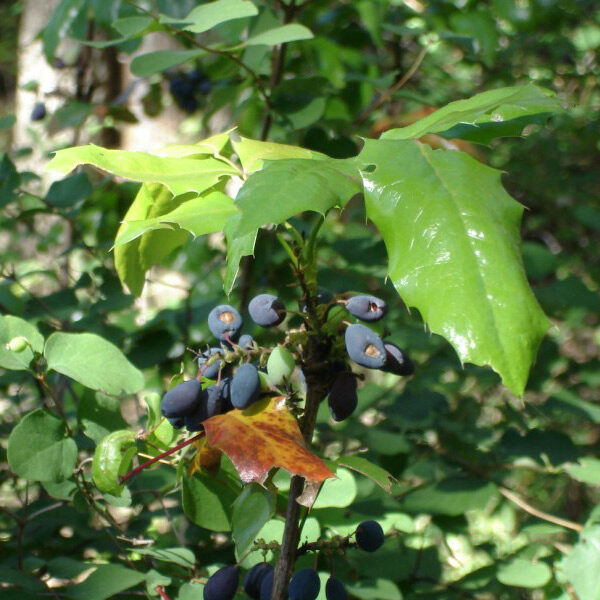Tall Oregon-grape
Mahonia aquifolium (Pursh) Nutt. (Berberis aquifolium Pursh)

overview
Evergreen shrub from a rhizome; stems branched, stoloniferous to stiffly erect, 0.5-2.5 meters tall; bark and wood yellowish. Leaves: Evergreen, holly-like, alternate, pinnate; leaflets usually five to eleven, pinnately nerved more than twice as long as broad, mostly with 12-29 prominent spiny teeth, shiny above but less so beneath. Flowers: Inflorescence of clustered racemes 3-8 cm long; flowers yellow, the segments in sixes. Fruits: Clustered berries 7-14 mm in diameter, blue, glaucous, with a few large seeds, edible (Douglas et al., 1998).
other names
barberry, tall mahonia, shining Oregon-grape
family
Berberidaceae
ecological setting
Mesic to dry open or closed forests in the lowland steep and montane zones (Douglas et al., 1998), open sites (Pojar et al., 1994) and woods and thickets (Peck, 1961). Occurs from southern BC south through Washington, Oregon to California. Found from sea level to 1800 m in BC (Pojar and MacKinnon, 1994).
soil texture
Rocky sites with coarse and medium textured, well-drained soils (Pojar and MacKinnon, 1994).
nutrients
Nitrogen-medium soils (Klinka et al., 1989).
soil reaction salinity
pH 5 to 8 (USDA NRCS, 2001).
moisture regime
Moderately drought tolerant (Keator, 1994). Dry to moderately-dry; characteristic of moisture deficient sites (Klinka et al., 1989).
shade tolerance
Shade tolerant but prefers open exposed sites (Klinka et al., 1989).
successional status
Early successional to climax. Common on disturbed sites and under open-canopy Douglas-fir forests in the coast and interior (Klinka et al., 1989).
bec zone subzone status
CDF, IDF, ICH dry, PP, BG
site rehabilitation
Good species for stabilization of dry exposed sites because of its rhizomatous growth habit.
wildlife
Occasional winter browse of deer and elk (USDA, 1988). Leaves and fruit eaten by small birds and mammals.
landscaping
High quality landscaping plant. Useful in shrub borders, mixing well with other evergreen species. Showy, fragrant yellow flowers; edible berries; evergreen with some colour change in winter (S. Bastin, personal communication).
first nations
Eaten mixed with salal or other sweet fruit. Shredded bark or roots used to dye basket materials bright-yellow. Bark and berries used medicinally for liver, gall-bladder and eye problems. (Pojar and MacKinnon, 1994).
other uses
Used in floral arrangements. Used to make jellies, preserves and wine.
flowering time
April - early May
fruit ripening time
Mid-July – August
seed collection time
August - September
crop intervals
Annual
no seeds per kg
83,000 -94,000
seed viability
Germination variable - 30-50% (Marchant and Sherlock 1984).
collection and abstraction
Hand picking or flail onto cloths. Macerate berries immediately in water using a blender, and screen out or float off the pulp. Check fruits frequently prior to collection to determine collection timing and to avoid losses to birds and mammals. Mature seeds are a dark burgundy in colour and 3-5 mm in length.
seed storage
Dry seed superficially and store in sealed containers at 2-5º C (Rudolf, 1974; Banerjee et al., 2001).
fruit seed dormancy treatment
Stored seeds cold stratified for 90 days before planting in the spring. Alternatively for best results, sow seeds in fall covered with 0.3-1.3 cm of soil plus 0.5 cm of sand, and mulch until germination begins (Rose et al., 1998).
additional info and photos
For more information and pictures, visit the E-Flora BC website at www.eflora.bc.ca.